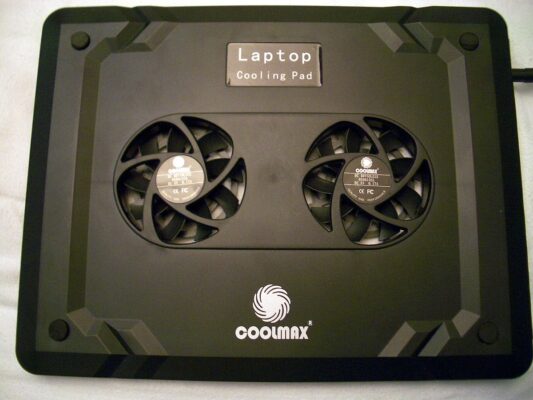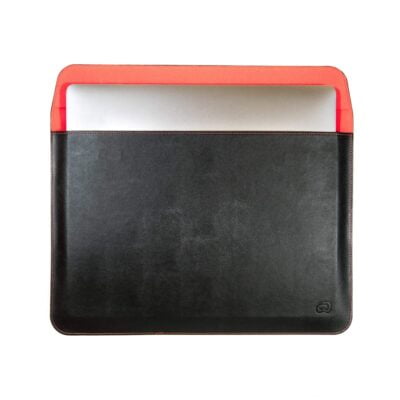The WaveWall Blog
Laptop on Lap Dangers
In today’s digitally-driven world, the laptop has become an extension of ourselves — a gateway to the internet, a workstation, an entertainment centre, and much more.
Studies reveal that people spend an eye-watering 1,700 hours a year in front of computer screens, including 6.5 hours on laptops for those who use them.
Laptops, while extremely convenient, can pose some unexpected health risks, especially when used directly on the lap for extended periods.
From thermal exposure to electromagnetic radiation and fertility concerns, it’s vital to understand that a laptop on lap poses serious risks.
We’ll explore each category of concern in detail, focusing on the inherent risks and various ways to protect yourself, including the often overlooked but highly effective use of shielding devices.
Table of Contents
Concerns Surrounding Laptop Thermal Exposure
Regardless of your gender, organs in and around your lap don’t want to be kept warm – or even hot – from artificial heat sources such as laptops.

Some laptops can get extremely hot, and while you might grow desensitised to it, that doesn’t mean your tissues and organs do.
Overheating
Laptops comprise multiple components like CPUs, GPUs, and batteries, all producing heat during operation.
When a laptop runs intensive tasks – like video editing, gaming, or multitasking with numerous applications – these components can produce more heat than during typical use.
Skin Burns
The laptop’s base, which dissipates much of the generated heat, can become extremely hot.
If the laptop remains in direct contact with the skin for an extended period, it might result in:
- Minor discomfort due to skin redness or the emergence of rashes.
- In severe cases, this can escalate to first-degree burns, which might necessitate medical attention.
- Prolonged heat exposure to the crotch and lap has been linked to infertility problems – more on that shortly.
Preventing Thermal Effects of Laptop on Lap
Using a Laptop Cooling Pad
A laptop cooling pad is a specially designed accessory that provides a barrier between your laptop and your lap.

These pads sometimes incorporate fans that actively push out the heat, whereas others contain materials that absorb heat.
By employing a cooling pad:
- Your laptop’s temperature can be considerably reduced, safeguarding the device’s hardware and ensuring comfort.
- The system performance will improve since lower operating temperatures – a win-win.
- You avoid overheating your crotch and lap.
When selecting a cooling pad, ensure it fits your laptop size.
Also, take note of how it’s powered. Some might draw power from the laptop’s USB port.
Placing the Laptop on a Hard, Flat Surface
Laptops are designed with specific cooling mechanisms like fans, and these work most efficiently when the device is on a hard, flat surface.
Such a surface allows for optimal airflow, ensuring the laptop’s cooling system operates as intended.
By using a hard surface:
- The laptop’s heat dissipation is improved compared to soft surfaces like beds or cushions, which might block the device’s air vents.
- The longevity of the laptop components can also be extended due to effective heat dissipation.
For those who don’t have access to a desk or a table at all times, consider using portable laptop desks or even a flat book.
Remember to ensure that the laptop’s air vents are not obstructed for efficient cooling.
Ergonomic Issues and Strain Injury
Using computers or laptops for long periods can cause ergonomic issues and strain injuries, including repetitive strain injury (RSI) and tendonitis.
Poor Posture
When you place a laptop on your lap, the screen is often lower than eye level, which provokes poor posture.
You may find yourself hunching over or bending your neck to get a better screen view. These actions are not benign – they can lead to many physical discomforts, especially in the neck and back region.
Over time, poor posture can contribute to more serious musculoskeletal problems, like chronic back or neck pain.
Millions of people suffer from posture-related issues related to poor computer/laptop work habits.
Wrist Strain
Laptops are designed for portability, not ergonomics. Consequently, the angle and positioning of the keyboard can be less than ideal for prolonged typing.
Users often experience wrist discomfort or strain because the angle of the wrists during typing is not neutral.
These strains can progress to more severe conditions like carpal tunnel syndrome or repetitive strain injuries (RSIs) if not addressed.
Preventing Musculoskeletal Issues
Use a Detachable Keyboard and Mouse
If you’re using your laptop for an extended period, consider using a detachable keyboard and mouse.
This allows you to customise your setup for ergonomic correctness. With a separate keyboard, you can adjust the height and angle so your wrists remain neutral while typing.
The same goes for a mouse – an ergonomically designed model can significantly reduce wrist strain.
A detachable keyboard and mouse can also position the laptop screen at eye level, perhaps by placing the laptop on a stand.
This can help alleviate the neck and back issues associated with looking down at your laptop screen for extended periods.
Sit at a Desk or Table That Allows for Better Posture
Opt for a desk or table when using a laptop for an extended time. In this setting, you can adjust your chair height and screen level to meet ergonomic guidelines, such as:

- Ensuring the top of the screen is at or slightly below eye level to reduce neck bending.
- Placing your feet flat on the floor or on a footrest.
- Adjusting the chair’s backrest to support the lumbar region of your back.
Electromagnetic Radiation
In recent years, the scientific and public discourse on the health impacts of electromagnetic fields (EMF) has gained momentum.
Virtually all electrical devices produce some level of non-ionising radiation, which researchers once believed was benign, as it doesn’t cause direct cellular damage like ionising radiation (e.g. gamma rays or X-rays).

However, the sentiment has changed, and evidence now strongly suggests that EMF exhibits some level of negative health consequences.
Most prolifically, an international coalition of more than 250 scientists, who collectively have authored over 2,000 research articles and letters, recently endorsed the International EMF Scientist Appeal.
This urgent call to action demands stronger health warnings and more stringent exposure restrictions to address the potentially harmful effects of EMF.
Concerns About EMF Radiation
Perhaps most alarmingly, brain tumours, such as gliomas, have increased, raising serious questions about the long-term health implications of sustained EMF exposure.

Moreover, even though mobile phones are regulated based on their specific absorption rate (SAR), emerging research suggests that the existing regulatory limits may be dangerously high.
The negative health consequences emerge even at exposure levels previously considered safe. Read more about EMF radiation here.
Radio Frequency (RF) Radiation
Laptops are near-constantly connected to WiFi or Bluetooth in today’s connected world.
These wireless technologies use radio waves to transmit data, meaning your laptop emits low levels of radio frequency (RF) radiation.
Extremely Low-Frequency (ELF) Radiation
ELF radiation comes from a laptop’s internal electrical activities, such as the operation of the hard drive, power supply, and other hardware components.
In the cases of RF and RLF, there is a chance that long-term exposure can affect cells negatively, possibly increasing the risk of numerous health problems.
Mitigation Strategies
Maintain a Distance Between the Laptop and Your Body
One of the simplest ways to reduce any potential risk from RF and ELF radiation is to increase the distance between the laptop and your body.
Even a small increase in distance can result in a significant reduction in radiation exposure. This can be achieved by placing the laptop on a desk or table rather than directly on your lap.
Alternatively, you can use a laptop shield or radiation-blocking lap desk that can be a barrier between the laptop and your body.
Use Your Laptop in Airplane Mode When Not Requiring Internet or Bluetooth Connectivity
Airplane mode disables the wireless communications functionalities of your laptop, effectively turning off WiFi and Bluetooth.
This is ideal when you’re performing tasks that don’t require internet connectivity or other wireless features.
Use Laptop Shields
Laptop shields designed to block radiation using Faraday Cage technology – which essentially disperses radiation away from the body – fit between your laptop’s base and lap.
These are a surefire method of cutting radiation and heat exposure, collectively making up for most laptop-related health risks.

Buy WaveWall’s lab-proven laptop shield here.
Laptop Fertility Concerns
Thermal and radiation absorption can lead to fertility issues. While the science here is not yet unequivocal, the evidence is growing – and even mainstream news publications are noticing.
Medical News Today released an article in 2010 specifying that laptop usage seriously affects male sperm quality, and recent studies have generally supported this sentiment.
Moreover, research into the risks for female fertility and sexual health has also proliferated.
A TIME magazine article investigated this issue, which delves into concerns about the impact of laptop use on male fertility.
Dr Jesse N. Mills from UCLA notes that male testicles need to be at least two degrees cooler than the rest of the body for optimal fertility, stating, “Our testicles like to be at least two degrees cooler than the rest of our body, and anything that affects their temperature can affect fertility.”
Dr Yefim Sheynkin, an associate professor of urology at SUNY Stony Brook, conducted research showing that after just an hour of laptop use, scrotal temperature increased by about 5 degrees Fahrenheit.
This elevated heat could potentially harm sperm count and quality. Sheynkin says, “If a laptop is used every day, testicular temperature remains elevated almost all the time—there’s not enough time for it to go back to normal.”
The article also finds credible the concerns surrounding EMF.
Fertility and EMF: Growing Evidence and Rising Concerns
The body of scientific evidence linking EMF, especially from cell phones, to male infertility and subfertility is both expansive and continually growing.
Given that laptops emit the same type of radiation, it stands to reason that the device could also hurt male reproductive health. Importantly, research extends beyond just cell phone studies to include specific investigations into the impact of laptops on fertility.
For instance, a 2012 study published by the American Society of Reproductive Medicine revealed that four hours of WiFi radiation exposure from a laptop resulted in decreased sperm motility, a crucial factor in reproductive health, and significant DNA fragmentation in sperm.

Intriguingly, this study highlighted that the damage to sperm was incurred at ‘nonthermal’ levels – indicating that the EMF radiation, rather than heat, caused this detrimental effect.
Another study, conducted in Japan in 2018 and published in 2019, corroborates these findings. Researcher Kumiko Nakata divided test subjects into three groups for the study: one exposed to EMF from a pocket WiFi router, another exposed to electromagnetic waves but shielded by WiFi EMF protection, and a control group with no EMF exposure.
After just two hours, the group exposed to WiFi radiation had significantly less viable sperm than the control group. This decrease in sperm viability was exacerbated over time, establishing a ‘dose-response’ relationship.
Pregnancy and EMF: Potential Risks to Mothers and Offspring
Increasing research highlights the potentially adverse effects of EMF exposure on pregnancy outcomes, including miscarriage and birth defects.
Notably, 2011 studies led by Dr. De-Kun Li from Kaiser Permanente indicate that EMF exposure in utero may be linked to the development of asthma later in childhood.
Specifically concerning laptops, another 2012 study illuminated that pregnant women and their foetuses might be exposed to more EMF radiation from laptops than from high-voltage power lines.
Mitigation Strategies: Precautionary Measures
Avoid Prolonged Laptop Use on the Lap
Given that both the heat and EMFs have the potential, at least theoretically, to affect male fertility, a straightforward mitigation strategy is to limit the duration of time spent with a laptop directly on the lap.
You can create a buffer that minimises these risks by placing the laptop on a table, desk, cushion, or lap desk.
The aim is not just to reduce exposure to EMFs but also to keep the testes cooler than they would be with the laptop placed directly on the lap.
The testes are sensitive to temperature fluctuations, so keeping them cool could be vital for maintaining optimal sperm health.
Consider Using a Laptop Shield
Again, a laptop shield offers a portable solution for situations where using a desk or table isn’t feasible. Shields block heat and EMFs, providing a barrier between the laptop and your body.
These shields are generally made of materials that absorb, dissipate, or reflect heat and electromagnetic fields, lessening direct exposure.
Buy WaveWall’s lab-proven laptop shield here.
Eye Strain: Delving Deep into Computer Vision Syndrome and Preventative Measures
Eye strain is something virtually any PC or laptop worker will experience at some point.
There’s no doubt that exposure to bright screens can temporarily affect eyesight, but the effects may be longer-lasting.
Concerns: The Burden of Blue Light and Constant Focus
Computer Vision Syndrome: More Than Just Tired Eyes
In the digital age, our eyes are put to task more than ever before.
With many of us spending hours on end staring at screens, a phenomenon known as computer vision syndrome (CVS) has become increasingly prevalent.
CVS is an umbrella term for a range of eye and vision-related problems resulting from prolonged computer, tablet, e-reader, and cellphone use.
When you’re working at a computer or staring at any screen, your eyes have to focus and refocus constantly. This repetitive task, combined with the glare and contrast from the screen, can strain your eyes over time.
Another element to consider is blue light. Digital screens emit blue light, and exposure to high amounts of blue light over time could harm our eyes.
While the research is still inconclusive about the long-term impacts of blue light on the eyes, there’s enough evidence to show that it can contribute to eye strain.
Symptoms of CVS can include headaches, blurred vision, dry eyes, and neck and shoulder pain. Poor lighting, screen glare, incorrect viewing distances, and an inadequate seating posture can exacerbate these symptoms.
Mitigation Strategies: Nurturing Your Eyes in the Digital Era
The 20-20-20 Rule: A Simple Practice with Profound Impact
One of the most widely recommended strategies for mitigating eye strain is the 20-20-20 rule.
The principle is simple: every 20 minutes, take a 20-second break to look at something at least 20 feet away.
This serves multiple purposes:
- Relaxing the Eye Muscles: Constantly staring at a screen requires our eye muscles to remain in a state of contraction. Shifting your focus to a distant object allows these muscles to relax.
- Reducing Dry Eyes: Blinking rates significantly decrease when we’re engrossed in on-screen tasks. By taking periodic breaks, you give yourself a chance to blink more, which moistens the eyes and reduces dryness and irritation.
- Rejuvenating the Mind: These small breaks also offer a momentary mental respite, reducing cognitive fatigue and helping maintain focus in the long run.
Using an External Monitor: Elevating Your Visual Experience
Using an external monitor can make a world of difference when working for extended periods, especially tasks that demand high concentration levels.
Here’s why:
- Bigger Screen, Less Strain: A larger screen means larger text, images, and videos, reducing the effort your eyes have to make to discern details.
- Customised Screen Positioning: With an external monitor, you can position the screen at the most ergonomic height and angle for your eyes. Ideally, the top of the monitor should be at or just below your eye level, allowing you to look slightly downward at the screen.
- Optimised Lighting: A separate monitor can be adjusted to minimise glare from surrounding lights, reducing one of the significant contributors to eye strain.
Additional Suggestions for Healthier Screen Time
Aside from the primary mitigation strategies, several other practices can further reduce the risk of eye strain:
- Adjust Screen Settings: Enhance text size and contrast for comfort, especially when reading or composing long documents. Opt for warmer screen tones to reduce blue light exposure, especially during the evening.
- Stay Hydrated: Drink plenty of water to prevent dehydration, which can exacerbate dry eyes.
- Consider Blue Light Filters: These are available for both computer screens and eyeglasses. They can reduce the amount of blue light exposure, especially during extended screen sessions.
- Regular Eye Check-ups: Ensure you have regular eye exams, and discuss any CVS symptoms with your optometrist. They can recommend specialised computer glasses or updates to your prescription.
Recommendations for Safer Use of Laptops
Embrace the Ergonomic Advantages of Desks and Tables
Make it a point to use a desk or table that allows for an ergonomic setup whenever possible.
Proper height and distance from the screen can minimise eye strain, while an appropriate chair can support good posture, reducing the risk of back and neck pain.
Don’t Underestimate the Power of Short Breaks
Long sessions in front of a laptop can be mentally and physically taxing. The importance of taking short breaks cannot be overstated.
Just a few minutes of standing, stretching, or moving around can refresh your mind, alleviate muscle tension, and even improve focus and productivity.
These breaks are also the ideal time to employ strategies like the 20-20-20 rule for eye health.
External Devices: Extend Your Comfort Zone
External keyboards, mice, and monitors can improve ergonomics and reduce strains.
An external keyboard and mouse can help you maintain a natural wrist position, reducing the risk of carpal tunnel syndrome.
An external monitor, as previously detailed, can be adjusted for optimal height and distance, significantly minimising eye strain.
Shielding Devices: Your Guardian Against Heat and Electromagnetic Emissions
A shielding device may be one of the most underutilised but highly beneficial tools for safer laptop use.
Laptop shields are designed to block heat and electromagnetic emissions from the device, reducing direct exposure to your body.
This is particularly significant when using a laptop on your lap, where concerns about heat and electromagnetic fields affect areas like the reproductive organs.
Summary: Laptop on Lap Dangers
Operating laptops on laps introduces several dangers, perhaps most alarmingly impacting fertility.
While this has been debated for some time, recent studies are tough to refute. Intuitively speaking, does it really feel right to expose your stomach and reproductive organs to laptop heat and radiation?!
Luckily, laptop pads are a surefire method of preventing this radiation from entering the body.
Simply place your laptop on the pad and enjoy the peace of mind of knowing you’re protected from excessive radiation exposure.
Many of these pads also protect the body from excessive laptop heat, too.
WaveWall laptop pads are lab-tested to block 87% of radiation exposure.

